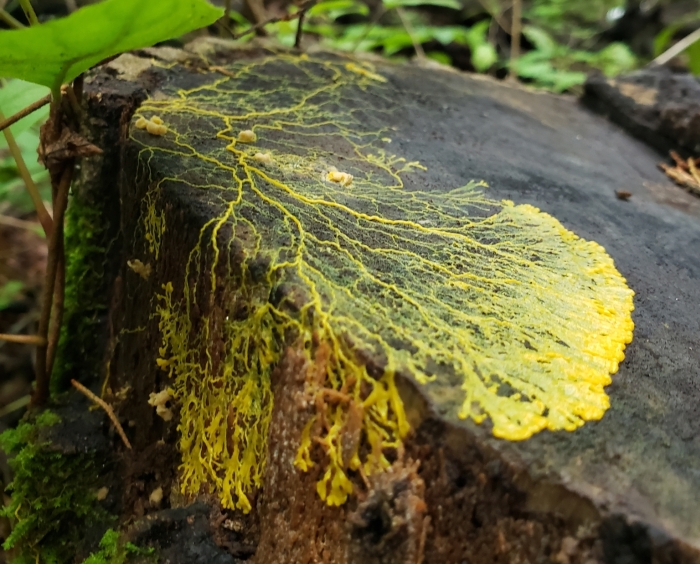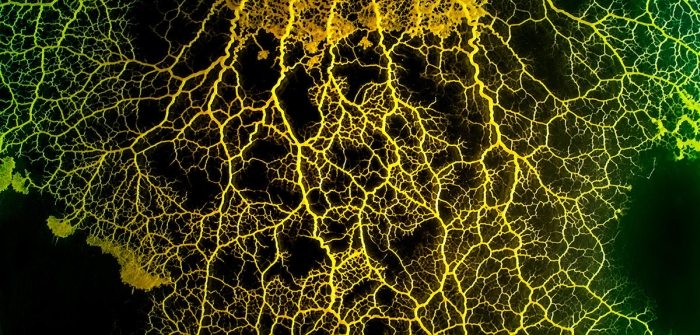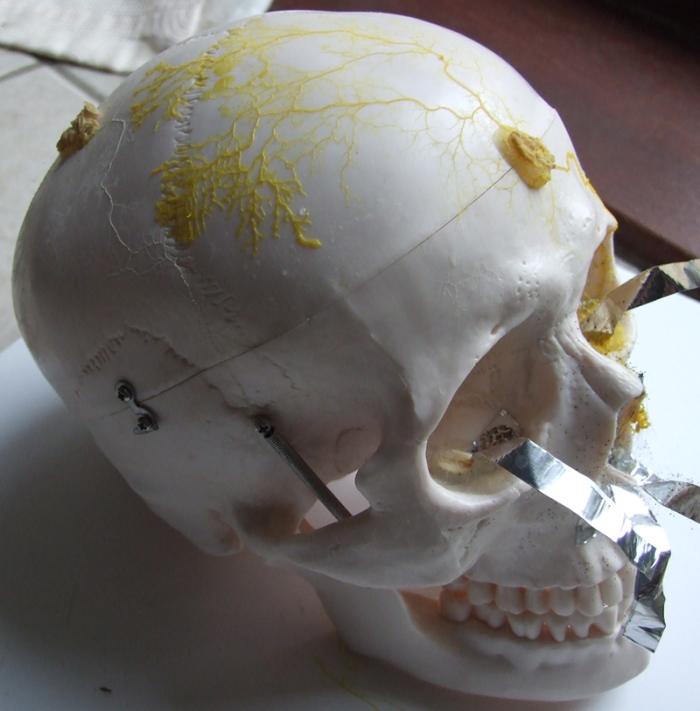Imagine you're walking into a forest, and you roll over a fallen log with your foot. Fanning out on the underside, there is something moist and yellow – a bit like something you may have sneezed out, if that something was banana-yellow and spread itself out into elegant fractal branches.
What you're looking at is the plasmodium form of Physarum polycephalum, the many-headed slime mold. Like other slime molds found in nature, it fills an important ecological role, aiding in the decay of organic matter to recycle it into the food web.
This bizarre little organism doesn't have a brain, or a nervous system – its blobby, bright-yellow body is just one cell. This slime mold species has thrived, more or less unchanged, for a billion years in its damp, decaying habitats.
And, in the last decade, it's been changing how we think about cognition and problem-solving.
"I think it's the same kind of revolution that occurred when people realized that plants could communicate with each other," says biologist Audrey Dussutour of the French National Center for Scientific Research.
"Even these tiny little microbes can learn. It gives you a bit of humility."
 P. polycephalum in its natural habitat. (Kay Dee/iNaturalist, CC BY-NC)
P. polycephalum in its natural habitat. (Kay Dee/iNaturalist, CC BY-NC)
P. polycephalum – adorably nicknamed "The Blob" by Dussutour – isn't exactly rare. It can be found in dark, humid, cool environments like the leaf litter on a forest floor. It's also really peculiar; although we call it a 'mold', it is not actually fungus. Nor is it animal or plant, but a member of the protist kingdom – a sort of catch-all group for anything that can't be neatly categorized in the other three kingdoms.
It starts its life as many individual cells, each with a single nucleus. Then, they merge to form the plasmodium, the vegetative life stage in which the organism feeds and grows.
In this form, fanning out in veins to search for food and explore its environment, it's still a single cell, but containing millions or even billions of nuclei swimming in the cytoplasmic fluid confined within the bright-yellow membrane.
Cognition without a brain
Like all organisms, P. polycephalum needs to be able to make decisions about its environment. It needs to seek food and avoid danger. It needs to find the ideal conditions for its reproductive cycle. And this is where our little yellow friend gets really interesting. P. polycephalum doesn't have a central nervous system. It doesn't even have specialized tissues.
Yet it can solve complex puzzles, like labyrinth mazes, and remember novel substances. The kind of tasks we used to think only animals could perform.
"We're talking about cognition without a brain, obviously, but also without any neurons at all. So the underlying mechanisms, the whole architectural framework of how it deals with information is totally different to the way your brain works," biologist Chris Reid of Macquarie University in Australia tells ScienceAlert.
"By providing it with the same problem-solving challenges that we've traditionally given to animals with brains, we can start to see how this fundamentally different system might arrive at the same outcome. It's where it becomes clear that for a lot of these things – that we've always thought required a brain or some kind of higher information processing system – that's not always necessary."
 (David Villa/ScienceImage/CBI/CNRS)
(David Villa/ScienceImage/CBI/CNRS)
P. polycephalum is well known to science. Decades ago, it was, as physicist Hans-Günther Döbereiner of the University of Bremen in Germany explains, the "workhorse of cell biology". It was easy to clone, and keep, and study.
However, as our genetic analysis toolkits evolved, organisms such as mice or cell lines such as HeLa took over, and P. polycephalum fell by the wayside.
In 2000, biologist Toshiyuki Nakagaki of RIKEN in Japan brought the little beastie out of retirement – and not for cell biology. His paper, published in Nature, bore the title "Maze-solving by an amoeboid organism" – and that's exactly what P. polycephalum had done. Nakagaki and his team had put a piece of plasmodium at one end of a maze, a food reward (oats, because P. polycephalum loves oat bacteria) at the other, and watched what happened.
The results were stunning. This weird little acellular organism managed to find the fastest route through every maze thrown at it.
"That triggered a wave of research into what other kinds of more difficult scenarios we can test the slime mold with," Reid says.
"Virtually all of those have been surprising in some way or another, and surprised the researchers in how the slime mold actually performed. It revealed some limitations as well. But mostly, it's been a voyage of revelation on how this simple creature can do tasks that have always been given to and thought to be the domain of higher organisms."
Full of surprises
Nakagaki recreated the Tokyo subway, with the station nodes marked out with oats; P. polycephalum recreated it almost exactly – except the slime mold version was more robust to damage, wherein if a link got severed, the rest of the network could carry on.
Yet another team of researchers found that the protist could efficiently solve the traveling salesman problem, an exponentially complex mathematical task that programmers routinely use to test algorithms.
Earlier this year, a team of researchers found that P. polycephalum can "remember" where it has previously found food based on the structure of the veins in that area. This followed previous research from Dussutour and her colleagues, who discovered that blobs of slime mold could learn and remember substances that they didn't like, and communicate that information to other blobs of slime mold once they fused.
"I'm still amazed by how, in a way, complex they are because they always surprise you in an experiment, they would never do exactly what you choose to do," Dussutour says.
In one instance, her team was testing a growth medium used for mammal cells, and wanted to see if the slime would like it.
"It hated it. It started to build this weird three-dimensional structure so it could go on the lead and escape. And I'm like, 'oh my gosh, this organism'."
A processing network
Although it's technically a single-celled organism, P. polycephalum is considered a network, exhibiting collective behavior. Each part of the slime mold is operating independently and sharing information with its neighboring sections, with no centralized processing.
"I guess the analogy would be neurons in a brain," Reid says. "You have this one brain that's composed of lots of neurons – it's the same for the slime mold."
That brain analogy is a really intriguing one, and it wouldn't be the first time P. polycephalum has been compared to a network of neurons. The topology and structure of brain networks and slime mold blobs are very similar, and both systems exhibit oscillations.
It's not entirely clear how information is propagated and shared in the slime mold, but we do know that P. polycephalum's veins contract to act as a peristaltic pump, pushing cytoplasmic fluid from section to section. And oscillations in this fluid seem to coincide with encounters with external stimuli.
"It's thought that these oscillations convey information, process information, by the way they interact and actually produce the behavior at the same time," Döbereiner tells ScienceAlert.
"If you have a network of Physarum go to a certain food, it changes oscillation pattern when it encounters sugar: it starts to oscillate quicker. Because of these quicker oscillations, the whole organism starts changing its oscillation pattern and starts to flow into the direction where the food was found."
He and colleagues recently published a paper demonstrating that these oscillations are extraordinarily similar to the oscillations seen in a brain, only a hydrodynamic system rather than electrical signals.
"What's relevant is not so much what oscillates and how the information is transported," he explains, "but that it oscillates and that a topology is relevant – is one neuron connected to 100 neurons or just to two; is a neuron connected just to its neighbors or is it connected to another neuron very far away."
 P. polycephalum growing on a life-sized model of a human skull. (Andrew Adamatzky, Artifical Life, 2015)
P. polycephalum growing on a life-sized model of a human skull. (Andrew Adamatzky, Artifical Life, 2015)
Defining cognition
As exciting as its escapades may seem, any researcher working with it will tell you that P. polycephalum is not, in itself, a brain. It's not capable of higher-level processing or abstract reasoning, as far as we can tell.
Nor is it, as intriguing as the notion may seem, likely to evolve into something like a brain. The organism has had a billion years to do so and shows no sign of going in that direction (although if any science fiction writers out there like the idea, feel free to run with it).
In terms of overall biology, slime mold is extremely simple. And by that very fact, it's changing how we understand problem-solving.
Just like other organisms, it needs food, it needs to navigate its environment, and it needs a safe place to grow and reproduce. These problems can be complex, and yet P. polycephalum can solve them with its extremely limited cognitive architecture. It does so in its own simple way and with its own limitations, says Reid, "but that in itself is one of the beautiful things about the system".
In a sense, it leaves us with an organism – a wet, slimy, damp-loving blob – whose cognition is fundamentally different from our own. And, just like the Tokyo subway, that can teach us new ways to solve our own problems.
"It's teaching us about the nature of intelligence, really, challenging certain views, and basically widening the concept," Reid says.
"It does force us to challenge these long-held anthropocentric beliefs that we are unique and capable of so much more than other creatures."

Comments
Post a Comment